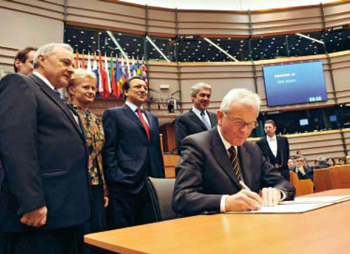Archive:National accounts at the heart of EU policies
This Statistics Explained article is outdated and has been archived - for recent articles on national accounts see here.
- Published in Sigma - The Bulletin of European Statistics, 2008/03
National accounts data lie at the heart of many European Union policies. They are the basis for how much the Member States contribute to the common EU budget. They determine who will receive regional funding. National accounts data are also essential for the management of the euro and the countries in the euro area. Sigma spoke to Laurs Nørlund, Director of National and European Accounts at Eurostat, about the use of national accounts data in EU policies.
Introduction
The interest in national accounts took off early in the 20th century, especially when government planning became fashionable. However, the golden age for national accounts at European level started some 30 years ago.
‘Policymakers wanted European data when they started devising new Community policies. National accounts data were especially interesting as they could be used to compare Member States on an equal footing in an equal framework. Since then national accounts lay at the heart of European policies and this development has gone hand in hand with a deep harmonisation of concepts and methodologies,’ said Mr Nørlund.
Regional development
The demand for national accounts data in the European Union has increased gradually. One of the first areas where data needs became apparent was regional development policy. The European countries have a common cohesion policy, which aims to decrease the economic and social differences within the European Union.
The regional policy really kicked off in the mid-1980s when Greece, Portugal and Spain became Member States. It was during this time that Eurostat developed the regional GDP data.
Today nearly 45 % of the EU’s budget, or EUR 60 billion, is spent each year on long-term regional development in those regions which have a GDP per inhabitant under 75 % of the EU average. Eurostat’s role is to provide GDP data for the 270 EU regions in question.
‘The definition of the regions is always a hot potato. Then comes the count of the people in the regions and finally the actual GDP data and the transformation in the purchasing power parities, which all put Eurostat work at the centre of regional policy,’ Mr Nørlund explained.
Billing the Member States
Another important piece in the puzzle of the use of national accounts is the fact that the Member States’ contribution to the EU budget is based on national accounts data. From the beginning, revenues were varied and came from, for example, customs duties, agricultural levies and value added taxes. Over the years other sources were added and some suppressed. Today the main chunk (70 %) is based on gross national income.
Eurostat’s role in the EU budget process is to validate the data submitted by the Member States, as well as the sources and methods they use. In October each year Eurostat sends the verified GNI data to the European Commission’s Directorate-General for the Budget, which uses the data to invoice the Member States.
‘We work closely together with the Budget DG and under close scrutiny of the Court of Auditors. In fact the Court of Auditors visits Eurostat at least 10 times per year, so we are probably the only Commission service under permanent audit by the Court. Member States also take a keen interest in our work, as their contributions amount to 1.24 % of their GNI,’ said Mr Nørlund.
Stability and growth pact
A multilateral economic surveillance in the European Union was introduced with the Maastricht Treaty’s Stability and growth pact. The European Commission evaluates the euro countries’ financial stability and the non-euro Member States’ convergence programmes. Countries wishing to join the euro area have to fulfil the so-called Maastricht criteria. All the criteria are based on statistical aggregates or other types of economic data. Both euro candidates and euro members should respect these numerical criteria. They concern a certain rate of inflation and interest rate and, on the national accounts data side, a government deficit lower than 3 % of GDP as well as a government debt less than 60 % of GDP. The aim is to maintain budgetary discipline in the monetary Union.
Eurostat reports debt and deficit data to the Commission and the Council twice a year, where the Economic and Financial Affairs DG assesses the situation in each Member State. Eurostat is also responsible for ensuring that the Member States correctly use the rules in the European system of accounts (ESA). If a new type of transaction comes up, which is not described in the ESA, Eurostat analyses the situation and clarifies how the transaction should be treated (see also Eurostat - Watchdog of European public finances).
‘The debt and deficit notification always attracts lots of interest, from the Member States and the media, and Eurostat has clearly gained visibility and discipline from the use of national accounts data,’ Mr Nørlund remarked.

Quality impetus
Mr Nørlund believes that the use of national accounts data in the EU has brought with it a very strong quality impetus.
‘The development of methodology, common concepts and standards has moved forward rapidly. Every Member State is interested in the data and that they are calculated correctly everywhere.’
As the national accounts data are used for important political decisions and are also crucial to monitoring Member States’ behaviour, pressure can be high on Eurostat.
‘There could be an unhealthy link between policy use and objective statistics production and there might be tensions, but I believe Eurostat has managed to maintain independence. At all levels in the Commission there is a profound respect for the need to maintain Eurostat’s professional independence. It is not easy, but it works,’ he pointed out.
In the future, Mr Nørlund sees a continued high demand for national accounts statistics.
‘My impression is that numerical targets and benchmarking will be even more en vogue in the future and an integral part of more EU policies. The national accounts provide a rigorous and precise framework in order to analyse and benchmark a variety of societal phenomena and set precise policy objectives.’

